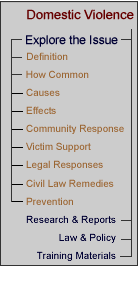|
|
|
6. Victim Protection, Support and Assistance NGOs provide a variety of support and assistance to battered women. Battered women are faced with violence, sometimes on a daily basis. Many women who seek help are ashamed of their situation and feel responsible for what is happening to them. They need to work with advocates who understand their situation and will help them determine for themselves what they need to do. Individual advocates counsel women and assist them in providing for their own safety. Advocates with legal expertise can provide advice that is not only helpful but necessary for victims seeking relief from the court system. While an advocate can help a battered woman understand the choices and options that are available to her, only the woman herself can make the decision about what course of action is best to her. Leaving an abuser may not always be the best choice, or there may be obstacles to leaving. She may not be able to support herself or her children or find alternative housing. She may fear that her batterer will retaliate against her or her children. To work effectively with battered women, an individual advocate need not be a psychological professional. The role of an advocate is to assist a woman in making her own decisions and providing for her own safety. Advocates around the world work successfully with battered women by following simple, but important, guidelines. One of the most important rules is to keep the information a battered woman provides confidential. Confidentiality is essential for the advocate to create a relationship of trust. Advocates must believe the women and affirm their ability to address their own problems. They must respect differences in background without judging. Advocates should listen actively and assist women with problem solving. Well-trained advocates can work in paid or volunteer positions. They are an important part of serving women victims of violence. Women are usually the best judges of the dangers their abusers pose to them. An advocate can help a battered woman assess the risk the batterer poses to her and develop a practical plan to keep herself safe. While evaluating risks and creating safety plans can help a woman, safety planning is no guarantee that she will not be injured. A safety plan is a plan a woman makes in which she identifies ways she can protect herself during a violent incident and reduce the risk of serious harm. The woman will follow the plan if she finds herself in immediate danger or if she must leave her home to preserve her safety. When counseling a woman on the issue of safety, an advocate must discuss whether the woman plans to stay in her home or plans to leave her abuser. If the woman wishes to stay in her home, she should plan to protect herself in the case of an incident to avoid injury or death. A woman must make other arrangements if she plans to leave. Does she have money? Is there a safe place she can stay? Has she considered that her husband may look for her? An advocate must discuss different approaches with a victim because she may change her mind before fully implementing any safety plan. She must also be prepared to change and revise her plan if something does not work. Lethal and Extremely Dangerous Behavior Violent relationships often become more violent over time. While it is impossible to predict with any degree of certainty when relationships will escalate to lethal violence, researchers have identified some common factors. Lack of the following circumstances does not necessarily indicate that violence will not become lethal. Battered women and advocates should always use extreme care in planning for safety and should rely on their own instincts in determining appropriate responses to violent situations. The advocate can help the battered woman assess the risk the batterer poses to her and develop a practical plan to keep safe. While safety planning can help a woman, safety planning is no guarantee that she will not be injured because women cannot insure their own safety on all occasions. Several factors have been identified to predict when batterers may use lethal violence. These include excessive jealousy or depression on the part of the batterer, stalking of the victim, threats of homicide or suicide in the past, drug or alcohol abuse. A risk of lethal violence has also been associated with the batterer’s possession of or access to weapons, the use of weapons or threats of such use in prior incidents, and escalation of the violence in frequency or severity. Legal professionals have identified the abuser’s prior “choking” or “strangling” of the victim as an indicator of extreme danger. Research indicates that the most dangerous time for a battered woman is after she ends the relationship. In the United States, research indicates that women who leave their batterers are at a 75% greater risk of being killed by their batterers than those who stay. From Julian Center, Women in the US; Casa de Esperanza, Myths and Facts. It is very important for a battered woman to make her own decision to leave a relationship because she is in the best position to assess the potential danger. In many countries around the world, NGOs have created shelters and safe home networks to provide temporary housing and other services to battered women and their children. Shelters generally are permanent structures with living facilities that provide a place for women to live with their children while they decide what to do about a violent situation. Often the addresses of shelters are confidential to keep the women in the facilities safe. In some countries, NGOs have begun to operate shelters with public addresses. The theory behind a public address is to acknowledge the violence in the community and to avoid adding to shame women may feel by staying hidden. Even shelters with public addresses, however, keep the identities of the individual women using their services confidential. An alternative to a shelter is a safe home network. A safe home network is group of people who are willing to take battered women into their homes on a short-term basis. Generally, people commit their homes for a defined period of time. The shift to different homes within the network helps ensure confidentiality. Crisis centers and hotlines provide support and counseling services to victims of violence. In many parts of the world, crisis centers and hotlines rely on trained volunteers to work with battered women. This type of assistance is based on the theory that women are the best judges of their own situations and support from peers rather than professional psychologists is an effective method of assisting the women in determining her best course of action. |
| Home | Contact | Feedback | Disclaimer |

